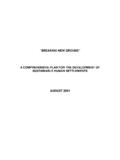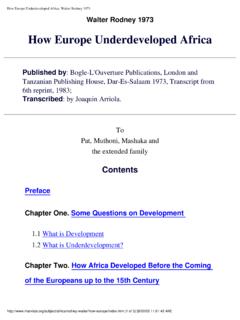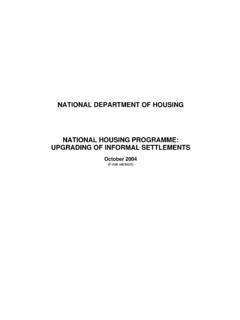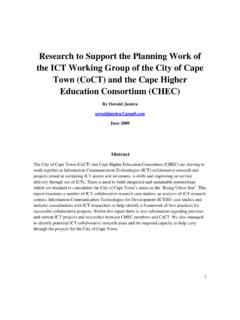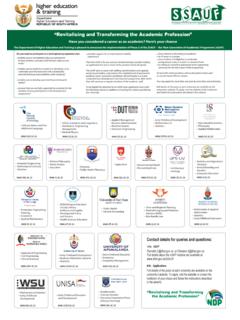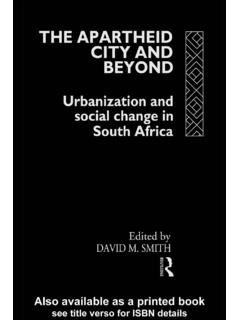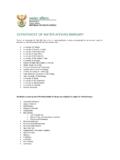Transcription of Forced Removals in Greater Cape Town, 1948-1970
1 Forced Removals in Greater cape town , 1948-1970 by Martin Legassick Introduction During and after the Second World War the African population of the cape Peninsula grew enormously in number. Until at least the mid-1950s most black Africans lived not in official locations such as Langa but in privately-owned and rented high density flats and houses along the docks-Observatory axis, scattered through the predominantly white and Coloured residential areas of cape town as plot owners or tenants -- and, mainly, under conditions of extreme squalor, in unregulated pondokkie settlements in the peri-urban areas around the fringes of cape In the 1950s, however.
2 cape town became a test case for influx control and racial segregation .2 Government policy, implemented by local authorities, forcibly removed the African population to official locations or endorsed them out of the area altogether. African Population of the cape Peninsula3 Year Official Estimates 1936 14,868 1944 40,000 1945 80,000 1946 37.
3 005 1 See inter alia J. Western, Outcast cape town ( cape town , Human and Rousseau, 1981), p. 46; M. Budow, Urban squatting in Greater cape town , 1939-1948" (BA Honours, UCT, 1976); B. Kinkead-Weekes, The solution of the African squatter problem in the 1950s (Fourth CT History Workshop, 3-4 June 1983); A. Sayers The Political economy of housing in the Western cape , 1940-1960" (UCT, B Social Science Honours, 1984); B.
4 Kinkead-Weekes Africans in cape town : State Policy and Popular Resistance, 1936-1973", ( , UCT, 1992); K. Kondlo, Miserable hovels and shanties on waterlogged wasteland: the political economy of peri-urban squatting in cape town , 1945-1960" ( , UCT, 1992); Kevin Greenback, Into the wild bushes of Nyanga: the growth, control and relocation of cape town s squatters, 1939-1955" (BA Honours, UCT, 1993); Y. Muthien, State and Resistance in South Africa, 1939-1965 (Avebury, Aldershot, 1994); H. H. Fast, Pondoks, Houses and Hostels: a history of Nyanga 1946-1970, with a special focus on housing ( , UCT, 1995); James Meier, On the Margins : The Emergence and Growth of Squatter Settlements in cape town , 1939-1960" ( , University of Florida, 2000).
5 2 James Meier, On the Margins , Chapter 7; Muthien, State and Resistance, p. 146 3 Kinkead-Weekes, The squatter problem , p. 25; Kinkead-Weekes, Africans in cape town , pp. 99, 226; Fast, Pondoks , pp. 36, 137-8; Kondlo, Miserable hovels , ; Meier, On the margins , Chapter 7 1948 170,000 1951 49, 793 65,000 1953 267,500 1954 80,000 105000 1955 309,000 Principles of policy towards Africans Prior to 1948.
6 While according to Kinkead-Weekes a policy of preference for coloured labour informed policy in the Western cape , the national and local authorities established no clear or coherent policy to deal with the increase in African population, particularly in the squatter settlements. However shortly after the election of the National Party government in 1948 the Minister of Native Affairs, Mr Jansen, said that a question which will require very serious consideration is whether the population of Natives in the Western Province must not be reduced very drastically 4 In 1953 the Secretary for Native Affairs, Eiselen, complained of the ring or outer circle of unplanned.
7 Uncontrollable and without exception illegal concentrations of Bantu who drift towards the cities settled in camps which local authorities cannot control 5 In 1954 the Manager of Native Affairs for the cape town City Council told ANC stalwart Dora Tamana and the young Ben Turok that the policy of this government is to reduce the number of African families living in the Western The labour needs of the Peninsula are to be met by migratory labour .6 These as applied to the Western cape were official articulations of the Coloured Labour Preference Policy (CLPP) which was formally introduced in 1954 During the 1950s various measures were put in place to tighten up influx of Africans into the Western cape and to remove those illegally The aim was to turn as many of the African population as possible at first into single migrant labourers, and later to eliminate them altogether.
8 The African family came under direct assault by the state. 9 Thus housing built in Nyanga in the mid-1950s had to be convertible from family to single 4 cape Times, 21/8/1948 quoted in B. Kinkead-Weekes, The squatter problem , p. 7 5 W. M. Eiselen, paper to conference of Institute of Administrators of Non-European Affairs, July 1953, Grahamstown, quoted in Greenback, p. 60 6 New Age, 9/2/1956 7 See for example D. Hendrie, The Coloured Labour preference policy: a chronology in D. Horner(ed), Labour Preference, Influx Control and Squatters: cape town entering the 1980s ( cape town , 1983); Y.
9 Muthien, State and Resistance, pp. 73-6; B. Kinkead-Weekes Africans in cape town , passim; I. Goldin, Making Race () 8 These are dealt with in, for example Muthien, State and Resistance; Kinkead-Weekes, Africans in cape town . 9 Meier, On the margins , Chapter 7 accommodation, and then reconvertible to family accommodation for The period during which African entrants could legally seek for work in cape town was reduced in 1950 from two weeks to three days11, a measure extended nationally in the 1952 Native Laws Amendment Act. In 1954 African women in the Western cape were issued with work permits and in 1954/5 African men were issued with the new reference books (a new form of the dompas).
10 This was to have enormous ramifications for Africans in the Combined Municipalities. Within a year, these documents formed the basis upon which officials decided which families qualified to remain in the Peninsula. 12 At the end of 1959 the Native Affairs Department put an embargo on recruitment of new Africans to cape town . Together with this there was the destruction of the unregulated areas of residence in which the majority of Africans were living, and their forcible removal into bachelor compounds and proclaimed locations involving a spatial re-mapping of the cape Peninsula.

